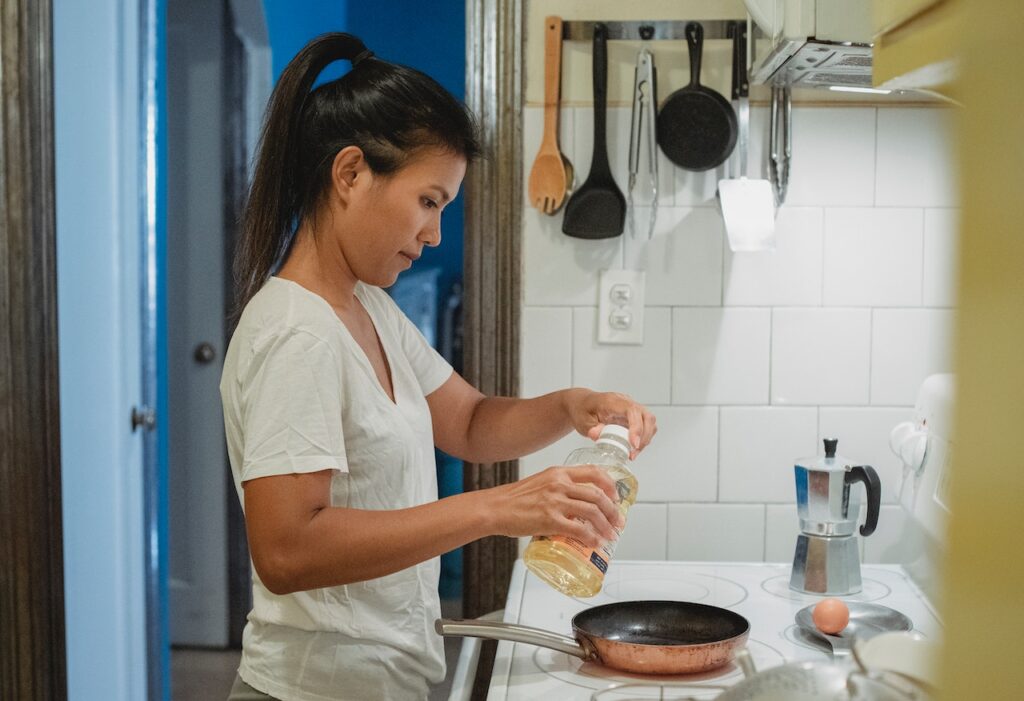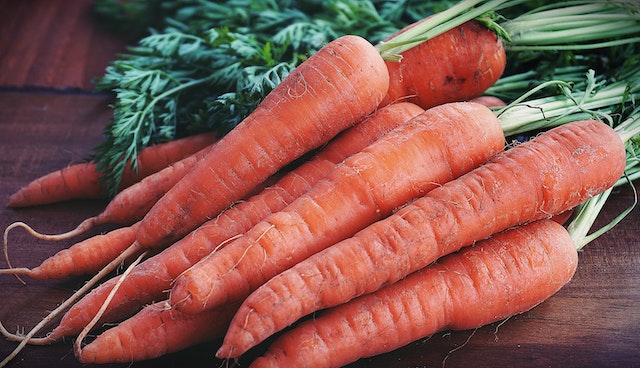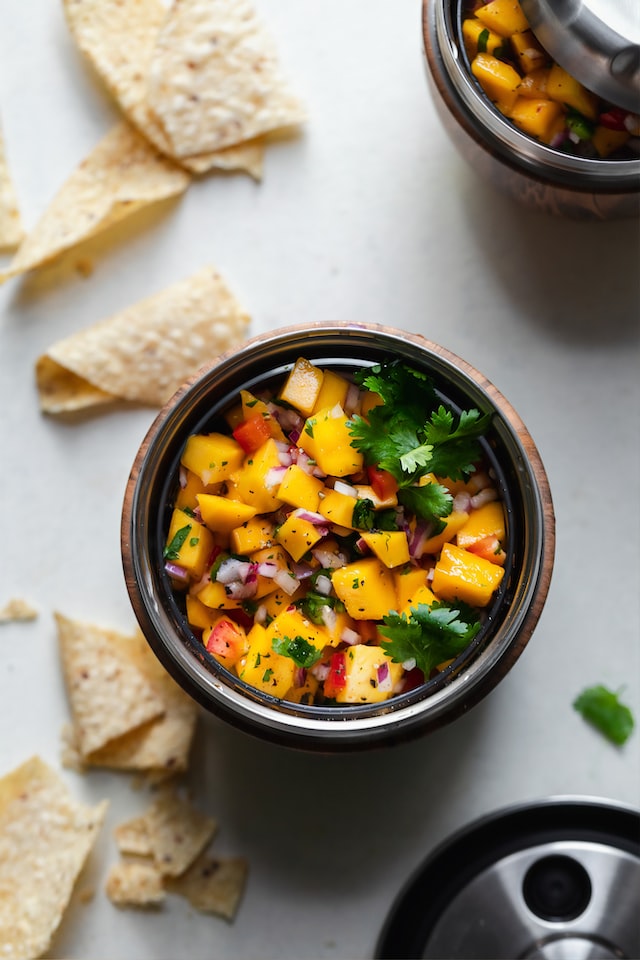by | Dec 30, 2022 | Food |
Cooking can be arduous, but it doesn’t have to be. With a few simple strategies, you can make your kitchen more efficient and make cooking easier. This article will provide step-by-step instructions on taking advantage of your kitchen’s efficiency and keeping the cooking process as simple as possible.

Via Pexels
Prepare Ahead of Time
Preparing ingredients before cooking is one of the most essential steps for efficient cooking. For example, cut vegetables ahead of time so that you don’t spend too much time prepping them during the cooking process.
Ensure that all ingredients are measured out correctly and that any marinades or sauces are prepared in advance. This allows for a smooth transition between ingredients and steps, making the overall process much more manageable.
Streamline Your Cooking Process
Start by getting organized. Keep your pots and pans clean and in easy-to-reach locations. Make sure you have all the necessary utensils nearby so you don’t have to search for them once you start cooking.
Also, try not to overcrowd your workspace; it will be challenging to move around if there is too much clutter on the countertop or stovetop.
Additionally, use a timer to ensure that each stage of the cooking process is timed correctly and nothing gets overcooked or burned.
Use Multi-Purpose Appliances
Take advantage of multi-purpose appliances. Pressure cookers, instant pots, slow cookers, and air fryers are great tools to have in the kitchen because they can do various tasks quickly and easily.
Pressure cookers are great for making stews, soups, and roasts in a fraction of the time it would take to make them on the stove. Instant pots can be used for anything from sautéing vegetables to making chicken. For example, here is an easy instant pot frozen chicken recipe that can be cooked in minutes. Slow cookers are perfect for low and slow cooking, like making chili or pulled pork. Air fryers are great for making crispy, fried foods without the use of oil. It is also a very healthy way of cooking because there is no need to deep fry.
Use Quality Cookware
Good quality cookware can make a huge difference in your kitchen efficiency. Look for pots and pans with thick bottoms to help distribute heat evenly and prevent burning. Non-stick surfaces also make for easier clean-up and less sticking.
Ensure your kitchen is stocked with all the necessary tools for whatever dish you cook. For example, if you’re making pasta, make sure you have a pot large enough for boiling water and a colander for draining the noodles. Preparing everything ahead of time will save you from running around searching for utensils during the cooking process.
Meal Prep and Freeze Leftovers
Prepping meals ahead of time is a great way to save yourself from cooking every night. Make extra portions and freeze them for future use. You can also make large batches of items such as soups, stews, or curry and freeze them in individual containers for easy access during busy weeks. This will save you time and money since you won’t have to buy any pre-made meals.
Clean Up Immediately
Cleaning up after cooking is one of the most tedious parts of the process. To make this easier, clean as you go—rinse dishes and utensils immediately after using them and wipe down countertops immediately. This way, you won’t have to face a massive pile of dishes at the end of your meal.
Invest In a Cooking Class
If you want to become a more efficient cook, consider investing in a cooking class. This can help teach you the basics of cooking and also give you tips on maximizing your kitchen efficiency.
Learning the fundamentals will help you understand how different ingredients interact and how to handle spices and herbs properly. You may even pick up some new recipes along the way!
Making cooking more efficient doesn’t have to be laborious. You can save time, energy, and money with simple steps. Start by organizing your kitchen workspace and using multi-purpose appliances to make the process easier. Next, invest in good quality cookware for even heat distribution and meal prepping for quick meals during busier weeks. Finally, clean up as you go to simplify the cleaning process afterward. These steps can help make your cooking experience much less stressful and more enjoyable!
by | Dec 15, 2022 | Food |
We all know that we must eat a balanced diet to lead the best quality of life possible. However, maintaining a consistently healthy diet is often easier said than done. We are constantly targeted by fast food ads. Convenience food is – as the name indicates – convenient, meaning we’re much more likely to reach for them than cooking up a storm in the kitchen. But you must get plenty of vegetables if nothing else. Here’s some information on the topic and some advice that could help!
 Image Source
Image Source
Why Eat More Vegetables?
A diet rich in vegetables can ensure you get the proper nutrients into your body. It can fuel you and help you to thrive. Various studies have been conducted on the subject, finding mixed results, including claims that a vegetable-dense diet can lower blood pressure, reduce your risk of heart disease, minimize chances of experiencing a stroke, prevent some forms of cancer, increase eye health and reduce the experience of digestive problems. Vegetables can also help you maintain healthy blood sugar levels, help you to maintain healthy eating habits, and keep your appetite in good order.
5-A-Day
It’s recommended that you get five portions of fruit and vegetables into your diet each day. Five portions will ensure that you are getting enough variety in your diet. Remember that you can’t just eat five portions of carrots. Each portion needs to be a different type of vegetable. This maximizes well-being. Each portion should also roughly fill the size of your palm.
Know How to Prepare Your Veggies
A lot of people think that they don’t like vegetables. While this can be the case for a few, most people haven’t found suitable vegetables for them. Preparation is key. Cooking a vegetable the right way can make the difference between being delicious or soggy, tasteless or bland. Instead, you need to take some time to learn how to properly prepare and cook any vegetables you might want to eat. There are countless tutorials out there. From how to cook asparagus to whether to steam or boil broccoli.
Leave the Skins On
If you can leave the skin on your vegetables, you should. This is often the best part of the vegetable in terms of nutrition. Vegetable skins tend to be packed with nutritional fiber. Up to 31% of a vegetable’s total fiber can be found in its skin! Do what you can to keep skins on.
Smoothies
If you make smoothies, this is an excellent opportunity to work a few extra vegetables into your daily diet. Sure, we tend to associate smoothies with fruit, but vegetables also have their place in them. Veggies tend to work best in green smoothies. Add kale and spinach to smoothies with frozen fruit, ginger shots, flax seed, and other goodies. High-speed blenders create the best smoothies, as they can break down stalks while maintaining a smooth, enjoyable texture.
Snacks
Replace unhealthy snacks – such as biscuits, cakes, and crisps – with vegetable-based snacks. This is a great way to work extra veggies in each day. Be creative. Try pepper slices or carrots dipped in hummus. Bake your own vegetable crisps from carrots, beetroot, parsnip, and more.
Soups
Vegetables can be packed into soups easily. This is a warming meal that is perfect for the winter months. Good options include cream of tomato, butternut squash, chunky vegetable soup, and more. It can be tempting to go for canned options out of convenience, but often, you can get more nutrients from healthy, homemade options. High-speed blenders are a good idea for this too.
Pasta Sauces
Pasta sauces are another way to pack lots of vegetables into one meal. Blended tomatoes, chili, olives, and more. Choose to have them smooth or chunky. Again, homemade tends to be a better option, as you can monitor and manage what gets in. This can reduce excessive salt or sugar levels too. You could add more vegetables to your pasta-based dishes, such as vegetable lasagne with vegetable slices instead of pasta sheets.
Switch to Sweet Potato
Sweet potato is a healthier alternative to standard potatoes. Where possible, switch the standard potatoes out for their sweet alternatives. Baked sweet potatoes, sweet potato mash, and more are great options.
Hopefully, some of the tips above will help you to incorporate more vegetables into your diet!
by | Dec 13, 2022 | Food |
As the weather cools, you may yearn for some cozy meals. Luckily, there are plenty of ways to make your winter cozier than ever before. From cozy vegetarian dishes to dinner parties with a dash of whimsy and charm, there are so many foolproof ideas to help you get through this season. As the temperature starts to cool, people tend to hunker down at home more than usual and often eat less healthy foods.
Cozy meals don’t necessarily have to be super elaborate either: from hearty stews to simple soups. So, here are some tips for making all of these winter meals feel a little cozier this season!
 Photo by Libby Penner on Unsplash
Photo by Libby Penner on Unsplash
Try New Dishes You Haven’t Tried Yet
The best way to make your winter cozier is to try new dishes you haven’t tried yet. It can get pretty boring to eat the same foods over and over again, even if this is something that you’re doing with your family. While yes, it’s nice just getting to stick to the basics you’re comfortable with, the only way you can expand your palate is going to be by simply expanding it and try out new foods and dishes. Whatever you choose, it’s important that you have some degree of whimsy in your meal planning. If you want to get fancy, plenty of recipes out there can help make your winter cozy but fun too!
Bring Out The Dishes You Have Been Loving
Bring out your favorite dishes for the wintertime. This can mean anything from a bowl of hearty stew to a hearty casserole. Make sure to keep some staple recipes on hand so you can have warm and cozy meals all season long. What better way to get through the cold weather than by warming up to a dish that you love?
Build Around A Preference
If you’re looking for a way to make your winter meals feel cozier, try building around a preference. Instead of trying to make all your meals into cozy ones, find one that you already like and focus on making it better. Maybe you already love cooking but want something new. Try adding some warming spices or herbs that are traditionally used to add warmth to dishes.
If you have a particular craving, try experimenting with different ingredients in the same dish until you find what works for it. Another option is to create comfort food from scratch. Comfort food can be anything from macaroni and cheese (the ultimate comfort food) to hot chocolate (soothing and comforting). By creating these dishes yourself, you can also control the ingredients without sacrificing any of the comfort factors.
Stay Away From Take-Out And Convenience Foods
The first step to feeling cozy is avoiding the temptation of take-out food. While it may seem like a great idea since you can avoid cooking, it’s actually not. Take-out food is often loaded with sodium, sugar, and preservatives that have been linked to weight gain and other health issues. It also doesn’t give you time to prepare a healthy meal in advance, so you end up eating at home what could otherwise be healthier dishes.
Soups Are a Must!
If you’re looking for a comforting winter meal or even something for those busy evenings, soup is a great way to go. They make winter feel more homey and cozy, so they are perfect for those cold days when you want to stay in. Soups can be spicy or mild depending on your family’s tastes, and can also be made with ingredients from leftovers in the fridge.
With soups, there are endless possibilities as well. You could make a creamy tomato soup with meatballs for dinner one night and then vegan lentil chili on another. Get creative with soup-based recipes that will warm your soul!
No Meal Will Feel Complete Without Bread Or Sweets
One of the most classic winter meals, bread and pastries will always be a perfect accompaniment to any meal. Whether it’s a hearty soup or roasted vegetables, there’s nothing like a slice of toast to add fuel to your fire. Who doesn’t love serving up some hearty bread with their soups? However, you could always bring some dessert into the mix instead. Why not consider a buttermilk pie recipe to go with your winter meals? You’ll know for a fact that the food is going to be delicious!
by | Dec 1, 2022 | Food |
Everyone wants to treat themselves, and we all have our vices. But most people also want to make sure that they eat and live more healthily, which means cutting down on a lot of what we enjoy.

Pineapple Upside Down Cake
If you are trying to make changes in your life and your diet, you might struggle with this. Here are some tips to help you to have your cake and eat it too, both metaphorically and literally.
A Lifestyle Change, Not a Diet
One huge mistake that a lot of people make is that they go on diets that promise quick results. You can lose a lot of weight in a short amount of time on some of these diets, especially if you cut out huge amounts of food.
However, this kind of weight loss isn’t healthy or sustainable. Ideally, you should change your diet with the goal to be more healthy, not just lose weight. But rapid weight loss puts stress on your body. Not only that, but it’s often temporary.
A common result of rapid weight loss diets is that, while you lose weight quickly, it doesn’t take much time to put it back on again. These diets can be incredibly restrictive, meaning that once it’s over, you fall back into old eating habits, and then some. Some people even gain more weight than they lost.
The idea should be to change how you eat, not just what you eat. Everyone has different eating habits, some more healthy than others. By focusing on how you see food, you can make changes. This, especially when paired with increased exercise, will make it more viable for you to not only lose weight, but to live a healthier lifestyle.
Switching Food Choices
We can be our own worst enemies, especially when it comes to food. But there are some relatively simple ways to switch to a more nutritious diet. Rather than concentrating on restriction and cutting things out entirely, why not switch some of your food choices for healthier options?
If you’re a chronic snacker, for example, switch out the chips for something that will fill you up and provide more benefits. Fruit is a great option, but you can also find some snack alternatives that will provide the savory crunch that you’re craving, but without the saturated fats or unhealthy helping of salt.
Think of things like chips, cake, and other junk food as treats, rather than an ordinary part of your diet. Rather than restricting yourself, you’re treating yourself.
Dealing With Food Restrictions
Some people have food restrictions that can make some treats impossible to enjoy. Rather than cutting them out entirely, or worse, eating them anyway and facing the consequences, why not make or find alternatives that you can eat safely?
For example, this gluten free Brooklyn Blackout Cake recipe is exactly as decadent and enjoyable as you’d hope for, but it’s also more accessible for people who can’t eat gluten. This means that you enjoy a treat without any risks
by | Nov 22, 2022 | Food |
In this modern age, where we are constantly bombarded with convenience and takeout options at every turn, it can be easy to forget the importance of planning our meals ahead of time. Planning meals in advance can help you save money, eat healthier food and reduce food waste. Meal planning also allows you to make sure that every meal is well-balanced and nutritious without having to spend too much time in the kitchen. Here are six reasons why planning your meals weekly is wise: Photo by S’well on Unsplash
Photo by S’well on Unsplash
You will save money
When you plan ahead for your meals, you can create a shopping list with only the items you need for each week’s recipes. This eliminates unnecessary purchases of ingredients or items that are not related to the meal plans for the week and helps keep your grocery bill down to a minimum. Planning ahead also allows you to take advantage of sales, coupons, and other discounts so that you can get more for your money.
You can eat healthier food
When you plan ahead for meals, you know exactly what ingredients and nutrients you need to include in the meal to make it balanced and nutritious. This way, you are more likely to opt for healthy foods like fresh fruits and vegetables instead of convenience snacks or processed food items that are not as good for your health.
You will reduce food waste
By planning ahead for each week’s meals, you can be sure that all the ingredients purchased are used up before they go bad. This helps to reduce the amount of food waste in your household, which is both cost-effective and environmentally friendly.
You will have more time to spend on other things
When you plan ahead for meals, it eliminates the need to think about what to cook each day. This way, you can spend less time in the kitchen and more time doing other activities like exercising or reading a book.
You will enjoy cooking more
Meal planning helps make cooking much easier since you already know what ingredients you need and how long it’ll take to prepare them. This way, you can go into your meal preparation with confidence, knowing that everything is under control. Plus, when you know exactly what ingredients are required for each dish, there is no room for error which helps make cooking more enjoyable overall.
You can be creative in the kitchen
Planning ahead for meals gives you an opportunity to experiment with different recipes and ingredients like the chicken stew recipe available here. Not only will this help you create interesting dishes, but it also allows you to discover new flavors and cooking styles that may become favorites in your household.
There you go!
Overall, planning your meals weekly is a smart move. Not only will it save money and reduce food waste, but it will also give you more time to enjoy other activities while ensuring that all of your meals are balanced and nutritious. So why not take some time each week to plan out your meals so that you can reap the many benefits? It’ll be well worth the effort.
by | Nov 8, 2022 | Food |
Winter is creeping up on us. The sun is rising later, the days are drawing in earlier, the temperature is dropping, and we face more harsh weather conditions. Wind, rain, sleet, and snow will appear in abundance over the coming months. So it’s not all too surprising that many of us will be reaching for means of warmth and comfort. This will be in the form of clothes, food, and drinks. For now, let’s focus on drinks. We’ll pick up plenty of winter warmers when we’re out and about – at coffee shops and restaurants. But have you considered making some of your own at home? Here are a few winter warmers you might want to try!

Image Source
Hot Chocolate
Hot chocolate is a firm favorite when it comes to the winter. Not only is it warming, but it’s sweet, delicious, and can be jazzed up with all sorts of additions. There are a few different ways to go about making hot chocolate. You could use a powder, or you may find that you prefer a squeezy chocolate sauce or a stir-in chocolate stick. Generally, it’s best to make your hot chocolate with all milk – cow or plant-based milk. This will make it thicker and more creamy than using hot water. Once your hot chocolate is warmed, pour it into your cup and leave a gap at the top. This can then be used to squirt whipped cream or whipped plant-based cream on top. Some people add marshmallows, some sprinkle chocolate powder, and some drizzle chocolate sauce.
Latte
Lattes are another popular option you might like to take into consideration. Unlike hot chocolate, this will give you a caffeine kick, perking you up when needed. A latte is created using a shot of espresso, but if you don’t have an espresso machine at home, you could always use a spoonful of your favorite instant coffee. This is then topped up with warm milk or plant-based milk. If you want more flavor, you can always add syrups. There are plenty of festive syrups available on the market, such as cinnamon, caramel, or even pumpkin spice syrups. Alternatively, you could follow a recipe such as a copycat Starbucks chai tea latte recipe. If you want to go all out, you could even try some latte art or use a stencil to sprinkle cinnamon or chocolate on top in a decorative design.
Hopefully, some of the suggestions above will meet your needs regarding winter drinks that can be easily made from the comfort of your own home!










Follow!